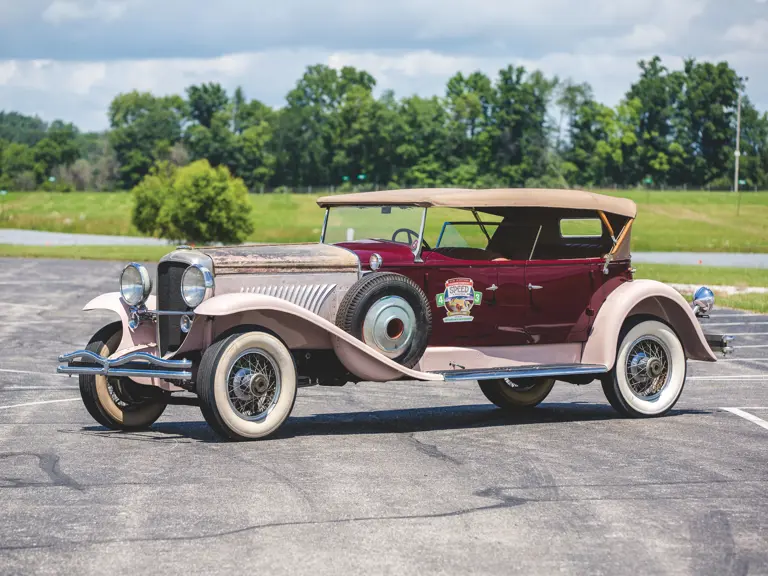
1931 Duesenberg Model J Tourster in the style of Derham
{{lr.item.text}}
$265,000 USD | Sold
{{bidding.lot.reserveStatusFormatted}}
- Correct Duesenberg straight-eight engine
- Manual transmission
- Renumbered bell housing
- Remanufactured frame & firewall
- Amsley-produced body in the Derham Tourster style
- Appeared at 2010 ACD Reunion
- Use of both original and remanufactured parts
- Offered in largely complete form
The Duesenberg Model J, affectionately nicknamed the “Duesy,” continues to represent anything truly great or grand today, regardless of the chosen spelling. It was bankrolled by E.L. Cord and designed from the outset to be the world’s finest car. When the Model J debuted at the New York Auto Salon on December 1, 1928, its launch dominated newspaper headlines.
The Model J’s visually impressive, 420-cubic inch, dual overhead cam, inline eight-cylinder engine featured a free-breathing, four-valve cylinder head, and it could develop 265 brake horsepower in normally aspirated form. Other remarkable features found on the Model J included a fully automatic chassis-lubricating system that operated every 30 to 60 miles, excellent two-shoe hydraulic drum brakes, and complete instrumentation, which included a 150-mph speedometer, a tachometer, an altimeter, an eight-day clock with a split-second stopwatch hand, and more. In short, from its introduction to the present, the Model J marks the crowning achievement of the Classic Era.
THE TOURSTER
The Tourster was Gordon Buehrig’s favorite Duesenberg. There is a lot to say about this handsome automobile, but the fact is that out of all of the creations that the master designer drew up for the mighty Model J, he preferred the Tourster, which speaks loudest of all.
The design was for a five-passenger touring car on the long 153-1/2-inch wheelbase Model J chassis, which in his 1972 autobiography, Rolling Sculpture, Buehrig described it as being “severely plain in ornamentation and [having] the unusual virtue of being equally handsome with the top in the raised position or when it is lowered.” The length of the chassis exaggerated the car’s lowered proportions, created by moving the rear seat ahead of the rear axle and the foot wells within the frame rails, which increased room for passengers while also allowing the top and sides of the body to be lower than on a standard phaeton.
With the Tourster, Buehrig also sought to solve a common problem of dual cowl phaetons of the time. They were often equipped with second windshields to give weather protection to rear seat passengers, but these windshields were mounted on hinged metal tonneaus that had to be clumsily swung up out of the way each time a passenger entered or exited the automobile. The Tourster’s solution was a rear windshield that slid up and down out of the back of the front seat with the turn of a crank handle, providing a windbreak that also looked appropriately dashing—and it stayed out of the way.
Eight original Toursters were produced in the early 1930s, all with coachwork by Derham & Company of Rosemont, Pennsylvania. So popular was the design, however, that numerous modern-day enthusiasts have worked with surviving Duesenberg components and well-proportioned recreated bodies to build “new” Toursters, with the result being cars with all of the same elan and driving thrill as the originals, at a considerably lower cost.
MR. HEISS’S TOURSTER
The Tourster shown here is a project upon which Mr. Heiss worked for many years, and is presented in nearly complete form. The frame was remanufactured in Mr. Heiss’s own shop, while the engine is a correct Model J unit with a renumbered bell-housing, J-394, and the firewall was reproduced and properly stamped in Mr. Heiss’s skilled hands. The body was acquired from the well-known restorer, Larry Amsley of Pennsylvania, who built several authentic and well-proportioned replica Tourster bodies using measurements taken from an original Derham Tourster that was being restored.
Over the years the car has been put together by the skilled Mr. Heiss using numerous original and remanufactured parts, with the body refinished in its present dark red with tan fenders, and the interior upholstered in tan leather. The car has a proper crank-operated rear windshield, in traditional Tourster style, and much of the correct instrumentation and features.
So proud was Mr. Heiss of his Duesenberg that, with the project nearing completion, he trailered the car to Auburn to attend the 2010 Auburn Cord Duesenberg Club National Reunion, where it was part of the world record gathering of Duesenbergs attending the famous Duesenberg Drag Race. Unfortunately, his health prevented further work on the car, which has remained in storage since its return from Auburn.
Today offered here in largely complete form, and ready to be finished by a new owner, this Tourster marks the completion of Frank Heiss’s years of dedicated enthusiasm to the Duesenberg and its many parts.


 | Auburn, Indiana
| Auburn, Indiana


